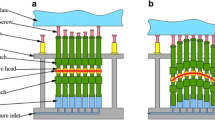Abstract
A finite element model was built for the sheet metal multi-point stretch forming (MPSF), and the model was applied to the MPSF of a typical part. The numerical simulation of the MPSF for a saddle and cylindrical surface workpiece was performed. The effects of non-uniform deformation of elastic cushion and spring back after unloading on the precision of formed workpiece were investigated. The simulation results show that using elastic cushion can effectively suppress generation of dimples, but have an effect on precision of formed workpiece. In addition, the amount of spring back after unloading is small, and the effect of the non-uniform deformation of the elastic cushion on the precision of the MPSF workpiece is larger than that of the spring back. A method based on the iterative corrections according to the numerical simulation results was proposed to compensate the non-uniform deformation of elastic cushion and the spring back to enhance the accuracy of MPSF.
Similar content being viewed by others
References
Li M, Nakamura K, Watanable S, Akutsu Y (1992) Study of the basic principles (1st report: Research on Multi-point forming for sheet metal). Proc. of the Japanese Spring conf. for Technology of Plasticity 519–522 (in Japanese)
Li M, Liu Y, Su S, Li G (1999) Multi-point forming: a flexible manufacturing method for a 3D surface sheet. J Mater Process Technol 87:277–280
Liu W, Jia S, Zhang C, Li M (2007) Generation and suppression of local severe plastic deformation in sectional multi-point forming. Int J Adv Manuf Technol 32:705–710
Liu C, Li M, Fu W (2008) Principles and apparatus of multi-point forming for sheet metal. Int J Adv Manuf Technol 35:1227–1233
Cai Z, Li M (2002) Multi-point forming of three-dimensional sheet metal and the control of the forming process. Int J Press Vessels Piping 79:289–296
Chen J, Li M, Liu W, Wang C (2005) Sectional multi-point forming technology for large-size sheet metal. Int J Adv Manuf Technol 25:935–939
Song X, Cai Z, Li M (2004) Numerical simulation on dimples and analysis on limited forming force in multi-point forming. Material science and technology 8:368–371 (in Chinese)
Cai Z, Wang S, Li M (2007) Numerical investigation of multi-point forming process for sheet metal: wrinkling, dimpling and springback. Int J Adv Manuf Technol 37:927–936
Karafillis AP, Boyce MC (1996) Tooling and binder design for sheet metal forming process compensating springback error. Int J Mach Tools Manufact 36(503):526
Li M, Cai Z, Sui Z, Yan Q (2002) Multi-point forming technology for sheet metal. J Mater Process Technol 129:333–338
Author information
Authors and Affiliations
Corresponding author
Rights and permissions
About this article
Cite this article
Liu, W., Yang, YY. & Li, MZ. Numerical simulation of multi-point stretch forming and controlling on accuracy of formed workpiece. Int J Adv Manuf Technol 50, 61–66 (2010). https://doi.org/10.1007/s00170-009-2501-1
Received:
Accepted:
Published:
Issue Date:
DOI: https://doi.org/10.1007/s00170-009-2501-1



